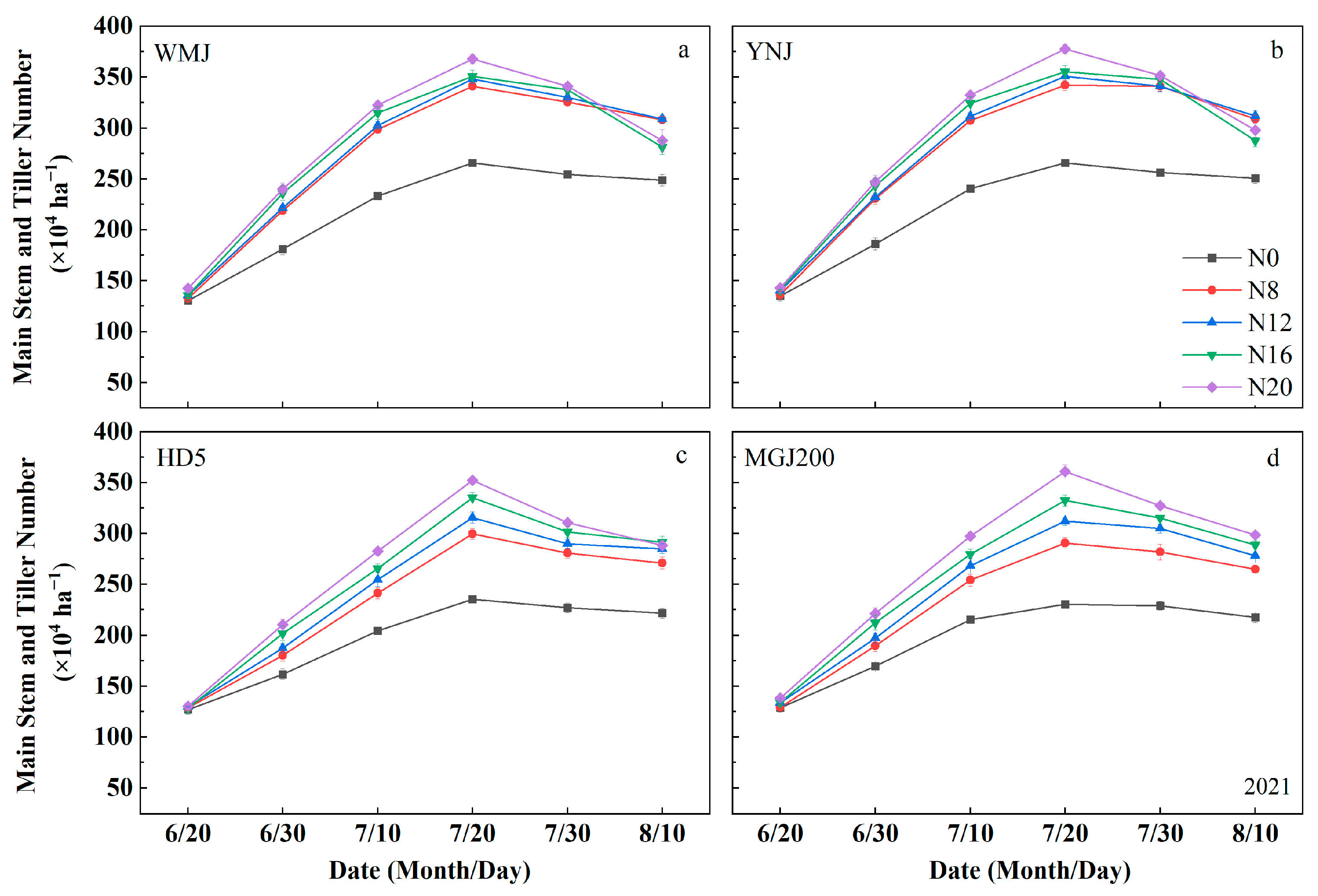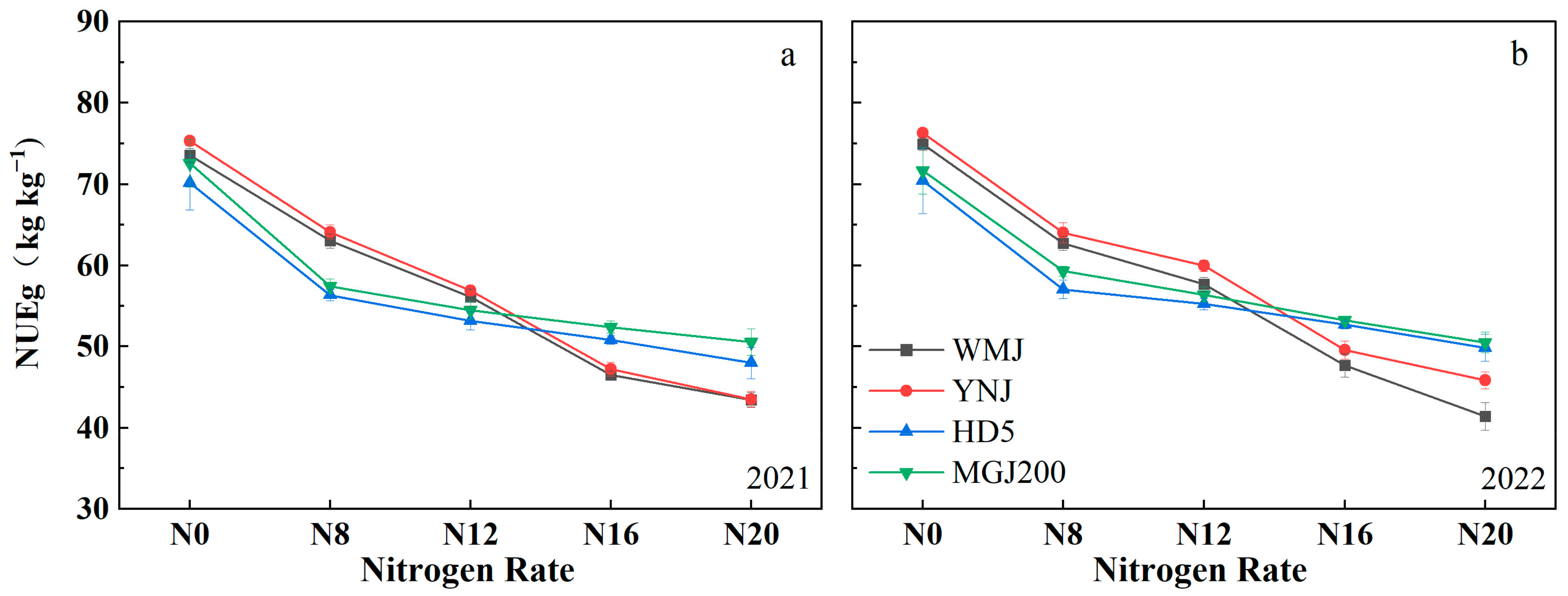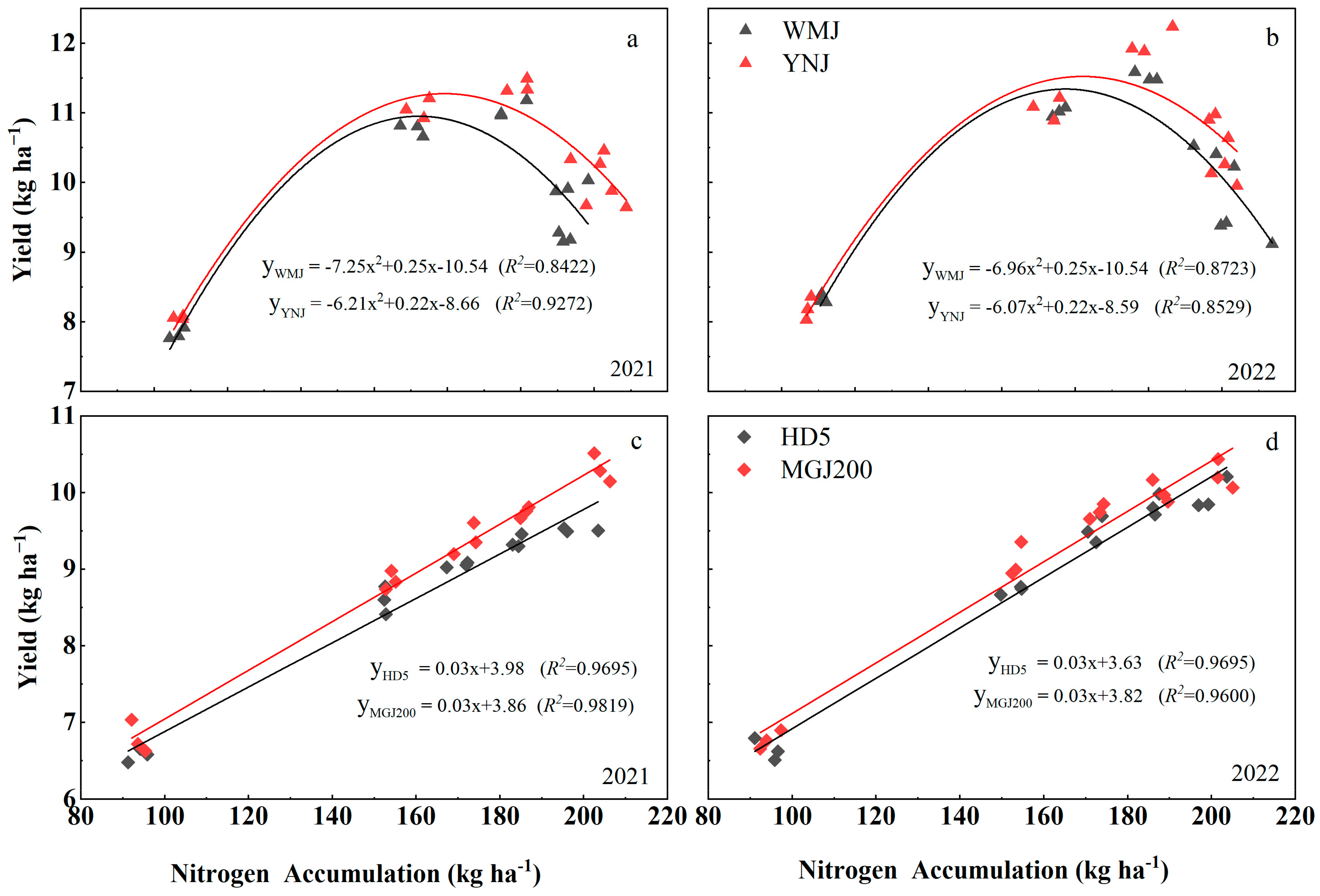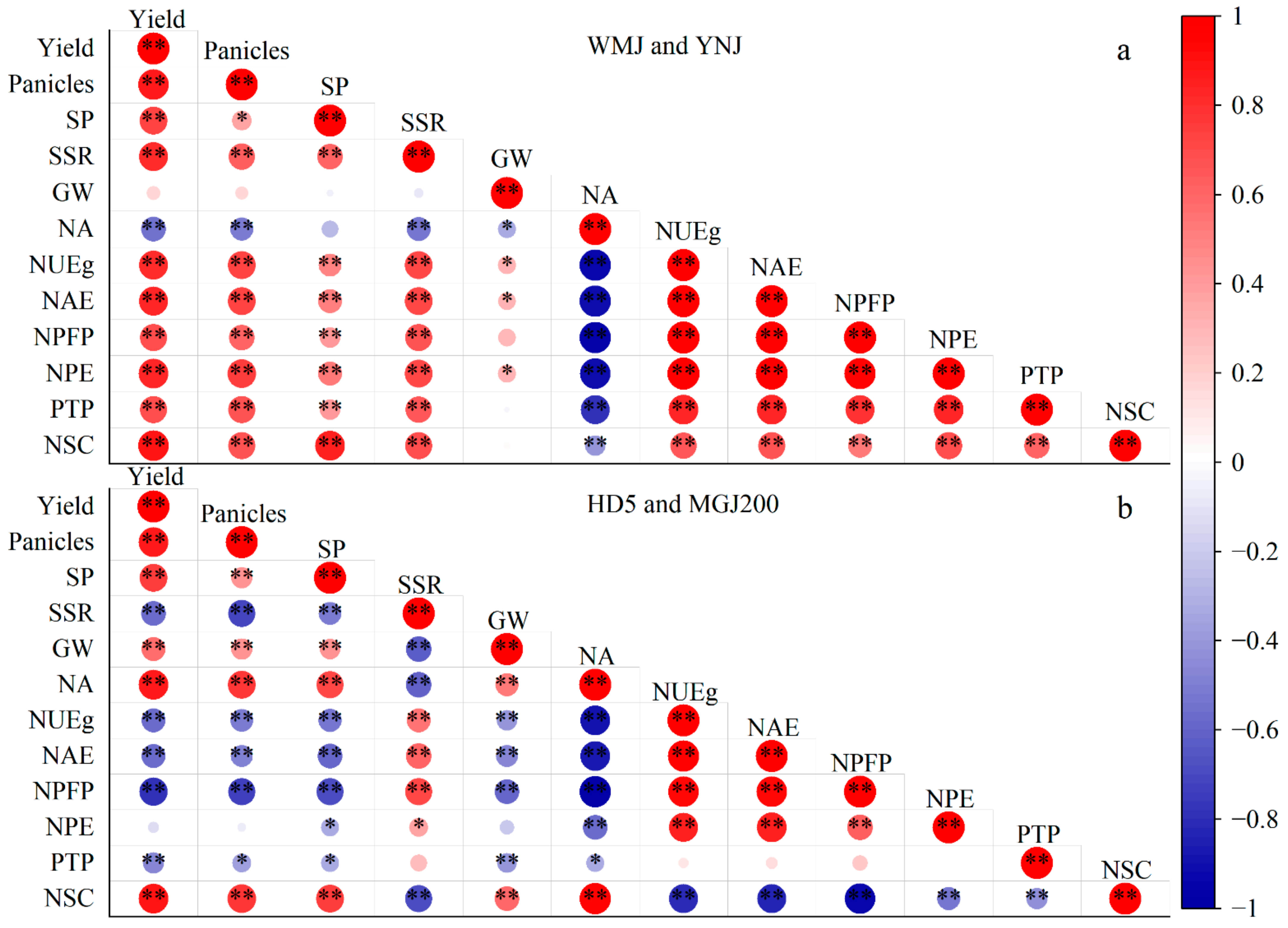Reduced Nitrogen Input Combined with Nitrogen-Saving japonica Rice Varieties Balances Yield and Nitrogen Use Efficiency in The Lower Reaches of the Yangtze River in China
Abstract
:1. Introduction
2. Materials and Methods
2.1. Field Conditions and Rice Varieties
2.2. Experimental Design and Growth Conditions
2.3. Sampling and Measurements
2.4. Determination of Yield and Its Components
2.5. Determination of Total N Content, Various N Use Efficiencies, and Estimation of Apparent Remobilized Non-Structural Carbohydrates (NSCs)
- Remobilized NSC in stem and leaves (Kg) = amount of biomass in stem and leaves at heading—amount of biomass transfer in stem and leaves at maturity;
- Ratio of remobilization of NSC in stem and leaves (%) = remobilized NSC in stem and leaves/amount of biomass in stem and leaves at heading;
- N accumulation (NA, kg ha−1) = dry matter weight in the above—ground × N content;
- N use efficiency for grain (NUEg, kg grain kg−1 N) = grain yield/N accumulation at maturity;
- Agronomic N use efficiency (NAE, kg grain kg−1 N) = (grain yield in N application plot—grain yield in N blank plot)/N rate;
- N partial factor productivity (NPFP, kg grain kg−1 N) = grain yield/N rate;
- N physiological efficiency (NPE, kg grain kg−1 N) = (grain yield in N application plot—grain yield in N blank plot)/(N accumulation in N application plot—N accumulation in N blank plot);
- NSC contribution to grain (%) = (NSC content in stems and sheaths at heading stage—NSC in stems and sheaths at maturity stage)/total grain yield.
2.6. Statistical Analysis
3. Results
3.1. Grain Yield and Yield Components
3.2. Tillering and Productive Tiller Percentage (PTP)
3.3. N Absorption and Use Efficiency
3.4. Non-Structural Carbohydrate (NSC) Remobilization
3.5. Correlation of NSVs and GVs with Yield and N Use Efficiency
4. Discussion
5. Conclusions
Supplementary Materials
Author Contributions
Funding
Data Availability Statement
Acknowledgments
Conflicts of Interest
References
- Pauline, C.; Sheetal, S.; Michelle, A.; Jon, H. Improving Nitrogen Use Efficiency—A Key for Sustainable Rice Production Systems. Front. Sustain. Food Syst. 2021, 5, 737412. [Google Scholar]
- FAOSTA. FAO Statistical Databases. Food and Agriculture Organization (FAO) of the United Nations, Rome. 2017. Available online: https://www.fao.org/statistics (accessed on 20 May 2023).
- Fang, H.; Zhang, Q.; Zhang, S.; Zhang, T.; Pan, F.; Cui, Y.; Thomsen, S.; Jakobsen, L.; Liu, A.; Pires, S. Risk-benefit assessment of consumption of rice for adult men in China. Front. Nutr. 2021, 8, 694370. [Google Scholar] [CrossRef]
- Nur, A.; Norhashila, H.; Rosnah, S.; Hasfalina, C. Rice for Food Security: Revisiting Its Production, Diversity, Rice Milling Process and Nutrient Content. Agriculture 2022, 12, 741. [Google Scholar] [CrossRef]
- Kai, C.; Sharon, P. A look at food security in China. NPJ Sci. Food 2018, 2, 4. [Google Scholar]
- Abbruzzini, T.; Davies, C.; Toledo, F.; Cerri, C. Dynamic biochar effects on nitrogen use efficiency, crop yield and soil nitrous oxide emissions during a tropical wheat-growing season. J. Environ. Manag. 2019, 252, 109638. [Google Scholar] [CrossRef]
- Liu, Y.; Wang, H.; Jiang, Z.; Wang, W.; Xu, R.; Wang, Q.; Zhang, Z.; Li, A.; Liang, Y.; Ou, S.; et al. Genomic basis of geographical adaptation to soil nitrogen in rice. Nature 2021, 590, 600–605. [Google Scholar] [CrossRef] [PubMed]
- Zhang, J.; Zhou, Y.; Wu, L.; Xu, C.; Liang, D.; Ding, Y.; Zhang, Y.; Wang, J.; Li, G. The Yield-Forming Role of Nitrogen in Rice in the Growing Seasons with Variable Thermal Conditions. Agronomy 2023, 13, 313. [Google Scholar] [CrossRef]
- Gu, J.; Yang, J. Nitrogen (N) transformation in paddy rice field: Its effect on N uptake and relation to improved N management. Crop. Environ. 2022, 1, 7–14. [Google Scholar] [CrossRef]
- Zhang, X.; Zhou, J.; Huang, N.; Mo, L.; Lv, M.; Gao, Y.; Chen, C.; Yin, S.; Ju, J.; Dong, G.; et al. Transcriptomic and Co-Expression Network Profiling of Shoot Apical Meristem Reveal Contrasting Response to Nitrogen Rate between Indica and Japonica Rice Subspecies. Int. J. Mol. Sci. 2019, 20, 5922. [Google Scholar] [CrossRef] [Green Version]
- Qi, D.; Wu, Q.; Zhu, J. Nitrogen and phosphorus losses from paddy fields and the yield of rice with different water and nitrogen management practices. Sci. Rep. 2020, 10, 9734. [Google Scholar] [CrossRef]
- Alam, M.; Khanam, M.; Rahman, M. Environment-friendly nitrogen management practices in wetland paddy cultivation. Front. Sustain. Food Syst. 2023, 7, 1020570. [Google Scholar] [CrossRef]
- Ju, C.; Liu, T.; Sun, C. Panicle Nitrogen Strategies for Nitrogen-Efficient Rice Varieties at a Moderate Nitrogen Application Rate in the Lower Reaches of the Yangtze River, China. Agronomy 2021, 11, 192. [Google Scholar] [CrossRef]
- Huang, L.; Yang, D.; Li, X.; Peng, S.; Wang, F. Coordination of high grain yield and high nitrogen use efficiency through large sink size and high post-heading source capacity in rice. Field Crop. Res. 2019, 233, 49–58. [Google Scholar] [CrossRef]
- Sun, T.; Yang, X.; Tan, X.; Han, K.; Tang, S.; Tong, W.; Zhu, S.; Hu, Z.; Wu, L. Comparison of Agronomic Performance between Japonica/Indica Hybrid and Japonica Cultivars of Rice Based on Different Nitrogen Rates. Agronomy 2020, 10, 171. [Google Scholar] [CrossRef] [Green Version]
- Huang, L.; Sun, F.; Yuan, S.; Peng, S.; Wang, F. Different mechanisms underlying the yield advantage of ordinary hybrid and super hybrid rice over inbred rice under low and moderate N input conditions. Field Crop. Res. 2018, 216, 150–157. [Google Scholar] [CrossRef]
- Wang, S.; Zhang, X.; Wang, C.; Zhang, X.; Reis, S.; Xu, J.; Gu, B. A high-resolution map of reactive nitrogen inputs to China. Sci. Data 2020, 7, 379. [Google Scholar] [CrossRef] [PubMed]
- Wang, C.; Zhang, Y.; Zhu, Z.; Chen, T.; Zhao, Q.; Zhong, W.; Yang, J.; Yao, S.; Zhou, L.; Zhao, L.; et al. Research progress on the breeding of japonica super rice varieties in Jiangsu Province, China. J. Integr. Agric. 2017, 16, 992–999. [Google Scholar] [CrossRef] [Green Version]
- Dong, G.; Zhou, Y.; Zhang, J.; Wang, J.; Zhou, J.; Chen, C.; Zhang, X.; Hua, H.; Shu, X.; Gao, Y.; et al. Introgression of qPE9-1/DEP1, a major QTL for rice panicle erectness, drastically improves nitrogen use efficiency under limited nitrogen supply. Eur. J. Agron. 2022, 133, 126444. [Google Scholar] [CrossRef]
- Liu, X.; Hu, B.; Chu, C. Nitrogen assimilation in plants: Current status and future prospects. J. Genet. Genom. 2022, 49, 394–404. [Google Scholar] [CrossRef] [PubMed]
- Cao, P.; Sun, W.; Huang, Y.; Yang, J.; Yang, K.; Lv, C.; Wang, Y.; Yu, L.; Hu, Z. Effects of Elevated CO2 Concentration and Nitrogen Application Levels on the Accumulation and Translocation of Non-Structural Carbohydrates in Japonica Rice. Sustainability 2020, 12, 5386. [Google Scholar] [CrossRef]
- Li, L.; Tian, H.; Zhang, M.; Fan, P.; Ashraf, U.; Liu, H.; Chen, X.; Duan, M.; Tang, X.; Wang, Z.; et al. Deep placement of nitrogen fertilizer increases rice yield and nitrogen use efficiency with fewer greenhouse gas emissions in a mechanical direct-seeded cropping system. Crop. J. 2021, 9, 1386–1396. [Google Scholar] [CrossRef]
- Liu, Y.; Li, C.; Fang, B.; Fang, Y.; Chen, K.; Zhang, Y.; Zhang, H. Potential for high yield with increased seedling density and decreased N fertilizer application under seedling-throwing rice cultivation. Sci. Rep. 2019, 9, 731. [Google Scholar] [CrossRef] [PubMed] [Green Version]
- Zhang, D.; Wang, H.; Pan, J.; Luo, J.; Luo, J.; Liu, J.; Gu, B.; Liu, S.; Zhai, L.; Lindsey, S.; et al. Nitrogen application rates need to be reduced for half of the rice paddy fields in China. Agric. Ecosyst. Environ. 2018, 265, 8–14. [Google Scholar] [CrossRef] [Green Version]
- Yousaf, M.; Li, J.; Lu, J.; Ren, T.; Cong, R.; Fahad, S.; Li, X. Effects of fertilization on crop production and nutrient-supplying capacity under rice-oilseed rape rotation system. Sci. Rep. 2017, 7, 1270. [Google Scholar] [CrossRef] [Green Version]
- Giao, N.; Surya, K. Improving nitrogen use efficiency in plants: Effective phenotyping in conjunction with agronomic and genetic approaches. Funct. Plant Biol. 2018, 45, 606–619. [Google Scholar]
- Liu, Y.; Hu, B.; Chu, C. Toward improving nitrogen use efficiency in rice: Utilization, coordination, and availability. Curr. Opin. Plant Biol. 2023, 71, 102327. [Google Scholar] [CrossRef]
- Vanessa, J.; Mark, A.; Mamoru, O. Strategies for engineering improved nitrogen use efficiency in crop plants via redistribution and recycling of organic nitrogen. Curr. Opin. Biotechnol. 2022, 73, 263–269. [Google Scholar]
- Wang, M.; Strokal, M.; Burek, P.; Kroeze, C.; Ma, L.; Janssen, A. Excess nutrient loads to Lake Taihu: Opportunities for nutrient reduction. Sci. Total Environ. 2019, 664, 865–873. [Google Scholar] [CrossRef]
- Lu, X.; Ma, L.; Yu, D.; Chen, Y.; Wang, X. Spatiotemporal Variation Characteristics and Driving Factors of Nitrogen Use Efficiency of Wheat–Rice Rotation Systems in the Taihu Lake Region. Front. Soil Sci. 2021, 1, 745974. [Google Scholar] [CrossRef]
- Shu, C.; Li, F.; Liu, D.; Qin, J.; Wang, M.; Sun, Y.; Li, N.; Ma, J.; Yang, Z. Heading Uniformity: A New Comprehensive Indicator of Rice Population Quality. Agriculture 2021, 11, 770. [Google Scholar] [CrossRef]
- Ding, J.; Zhang, X.; Ma, Q.; Li, F.; Tao, R.; Zhu, M.; Li, C.; Zhu, X.; Guo, W.; Ding, J. Tiller fertility is critical for improving grain yield, photosynthesis and nitrogen efficiency in wheat. J. Integr. Agric. 2022, 10, 5. [Google Scholar] [CrossRef]
- Hou, M.; Yu, M.; Li, Z.; Ai, Z.; Chen, J. Molecular Regulatory Networks for Improving Nitrogen Use Efficiency in Rice. Int. J. Mol. Sci. 2021, 22, 9040. [Google Scholar] [CrossRef] [PubMed]






| Month | Mean Temperature (C°) | Solar Radiation (MJ m−2 per Month) | Precipitation (mm per Month) | |||
|---|---|---|---|---|---|---|
| 2021 | 2022 | 2021 | 2022 | 2021 | 2022 | |
| May | 22.3 | 21.5 | 391 | 320 | 53.9 | 12.3 |
| June | 26.5 | 28.2 | 513 | 521 | 17.4 | 35.4 |
| July | 28.5 | 30.1 | 501 | 523 | 143.8 | 27.5 |
| August | 28.1 | 30.5 | 532 | 485 | 46.1 | 32.5 |
| September | 26.7 | 23.5 | 387 | 367 | 7.5 | 3.3 |
| October | 19.3 | 17.5 | 369 | 348 | 88.2 | 67.6 |
| Nitrogen Rate | Total Nitrogen (kg ha−1) | Base Fertilizer (kg ha−1) | Tiller Fertilizer (kg ha−1) | Spikelet- Promoting Fertilizer (kg ha−1) | Ratio |
|---|---|---|---|---|---|
| N20 | 300 | 90 | 120 | 90 | 3:4:3 |
| N16 | 240 | 72 | 96 | 72 | 3:4:3 |
| N12 | 180 | 54 | 72 | 54 | 3:4:3 |
| N8 | 120 | 36 | 48 | 36 | 3:4:3 |
| N0 | 0 | 0 | 0 | 0 | / |
| Type 1 | Variety 2 | Nitrogen Treatment | Panicles (×104 ha−1) | Spikelets Per Panicle | Seed Setting Rate (%) | 1000-Grain Weight (g) | Yield (t·ha−1) |
|---|---|---|---|---|---|---|---|
| NSV | WMJ | N0 | 248.83 ± 1.91 c | 125.23 ± 0.76 d | 89.37 ± 0.23 a | 28.09 ± 0.03 a | 7.82 ± 0.07 d |
| N8 | 308.20 ± 2.98 a | 148.17 ± 0.40 b | 85.19 ± 0.37 bc | 27.66 ± 0.07 b | 10.76 ± 0.07 b | ||
| N12 | 308.91 ± 3.69 a | 152.36 ± 0.94 a | 85.64 ± 0.17 b | 27.40 ± 0.09 b | 11.04 ± 0.10 a | ||
| N16 | 281.26 ± 0.66 b | 152.26 ± 0.54 a | 84.51 ± 0.18 c | 27.46 ± 0.13 b | 9.94 ± 0.07 c | ||
| N20 | 287.69 ± 3.24 b | 142.37 ± 0.81 c | 81.72 ± 0.45 d | 27.49 ± 0.19 b | 9.84 ± 0.13 c | ||
| YNJ | N0 | 250.51 ± 2.11 d | 127.56 ± 0.40 d | 89.80 ± 0.45 a | 28.08 ± 0.07 a | 8.06 ± 0.02 e | |
| N8 | 308.88 ± 2.03 a | 151.05 ± 0.77 b | 85.48 ± 0.08 b | 27.73 ± 0.06 ab | 11.06 ± 0.12 b | ||
| N12 | 311.98 ± 1.00 a | 155.06 ± 0.95 a | 85.59 ± 0.09 b | 27.48 ± 0.09 b | 11.38 ± 0.08 a | ||
| N16 | 287.61 ± 1.63 c | 154.86 ± 0.55 a | 84.43 ± 0.18 c | 27.53 ± 0.12 b | 10.35 ± 0.08 c | ||
| N20 | 297.85 ± 3.06 b | 144.80 ± 0.82 c | 81.84 ± 0.41 d | 27.57 ± 0.18 b | 9.73 ± 0.11 d | ||
| GV | HD5 | N0 | 221.87 ± 6.72 c | 112.21 ± 2.18 d | 92.53 ± 0.37 a | 28.55 ± 0.04 a | 6.57 ± 0.07 d |
| N8 | 271.10 ± 3.96 b | 130.94 ± 0.59 c | 90.53 ± 0.16 b | 26.75 ± 0.11 c | 8.60 ± 0.15 c | ||
| N12 | 285.15 ± 3.60 a | 134.64 ± 0.77 b | 86.83 ± 0.40 c | 27.17 ± 0.21 b | 9.06 ± 0.02 b | ||
| N16 | 291.24 ± 3.02 a | 137.13 ± 0.74 a | 85.58 ± 0.12 d | 27.39 ± 0.25 b | 9.36 ± 0.07 a | ||
| N20 | 288.49 ± 5.39 a | 137.50 ± 0.44 a | 87.58 ± 0.73 c | 27.39 ± 0.25 b | 9.51 ± 0.02 a | ||
| MGJ200 | N0 | 217.53 ± 1.14 e | 117.75 ± 2.25 d | 92.62 ± 0.37 a | 28.63 ± 0.04 a | 6.79 ± 0.17 e | |
| N8 | 264.77 ± 3.40 d | 137.49 ± 0.62 c | 90.62 ± 0.16 b | 26.83 ± 0.11 c | 8.85 ± 0.10 d | ||
| N12 | 278.13 ± 6.95 c | 141.62 ± 0.46 b | 86.88 ± 0.45 c | 27.44 ± 0.42 b | 9.39 ± 0.17 c | ||
| N16 | 288.93 ± 2.01 b | 143.98 ± 0.78 a | 85.30 ± 0.57 d | 27.47 ± 0.25 b | 9.75 ± 0.06 b | ||
| N20 | 298.44 ± 2.33 a | 144.37 ± 0.46 a | 87.60 ± 0.73 c | 27.34 ± 0.08 b | 10.32 ± 0.15 a | ||
| Source of variation | |||||||
| T | ** | ** | ** | ns | ** | ||
| V | ns | ** | ns | ns | ** | ||
| T × V | ** | ** | ns | ns | * | ||
| N | ** | ** | ** | ** | ** | ||
| T × N | ** | ** | ** | ** | ** | ||
| V × N | ** | ns | ns | ns | ns | ||
| T× V × N | ns | ns | ns | ns | ** | ||
| Varieties 1 | Yield Components | Direct Path Coefficient | Indirect Path Coefficient | Correlation | |||
|---|---|---|---|---|---|---|---|
| Panicles | Spikelets per Panicle | Seed Setting Rate | Grain Weight | ||||
| WMJ | Panicles | 0.7254 | 0.6040 | −0.3850 | −0.5065 | 0.9830 ** | |
| Spikelets per panicle | 0.3117 | 0.2595 | −0.1775 | −0.2609 | 0.9150 ** | ||
| Seed setting rate | 0.0234 | −0.0124 | −0.0133 | 0.0158 | −0.5494 * | ||
| Grain weight | −0.0152 | 0.0106 | 0.0127 | −0.0102 | −0.7668 ** | ||
| YNJ | Panicles | 0.6763 | 0.5838 | −0.4546 | −0.5069 | 0.9424 ** | |
| Spikelets per panicle | 0.5862 | 0.5060 | −0.3676 | −0.4711 | 0.9387 ** | ||
| Seed setting rate | 0.2765 | −0.1859 | −0.1734 | 0.1979 | −0.4941 | ||
| Grain weight | 0.0720 | −0.0540 | −0.0579 | 0.0516 | −0.7081 ** | ||
| HD5 | Panicles | 0.7648 | 0.7380 | −0.6790 | −0.5872 | 0.9853 ** | |
| Spikelets per panicle | 0.5748 | 0.5546 | −0.4882 | −0.4366 | 0.9886 ** | ||
| Seed setting rate | 0.2210 | −0.1962 | −0.1877 | 0.1060 | −0.8600 ** | ||
| Grain weight | 0.1796 | −0.1379 | −0.1364 | 0.0861 | −0.7382 ** | ||
| MGJ200 | Panicles | 0.8297 | 0.8048 | −0.7046 | −0.5920 | 0.9921 ** | |
| Spikelets per panicle | 0.5126 | 0.4972 | −0.4340 | −0.3910 | 0.9742 ** | ||
| Seed setting rate | 0.2415 | −0.2051 | −0.2044 | 0.1091 | −0.8150 ** | ||
| Grain weight | 0.1818 | −0.1297 | −0.1387 | 0.0821 | −0.6921 ** | ||
Disclaimer/Publisher’s Note: The statements, opinions and data contained in all publications are solely those of the individual author(s) and contributor(s) and not of MDPI and/or the editor(s). MDPI and/or the editor(s) disclaim responsibility for any injury to people or property resulting from any ideas, methods, instructions or products referred to in the content. |
© 2023 by the authors. Licensee MDPI, Basel, Switzerland. This article is an open access article distributed under the terms and conditions of the Creative Commons Attribution (CC BY) license (https://creativecommons.org/licenses/by/4.0/).
Share and Cite
Zhang, X.; Zhang, H.; Wang, Z.; Gao, Y.; Liu, X.; Shu, X.; Chen, Y.; Xiao, N.; Pan, C.; Zhou, J.; et al. Reduced Nitrogen Input Combined with Nitrogen-Saving japonica Rice Varieties Balances Yield and Nitrogen Use Efficiency in The Lower Reaches of the Yangtze River in China. Agronomy 2023, 13, 1832. https://doi.org/10.3390/agronomy13071832
Zhang X, Zhang H, Wang Z, Gao Y, Liu X, Shu X, Chen Y, Xiao N, Pan C, Zhou J, et al. Reduced Nitrogen Input Combined with Nitrogen-Saving japonica Rice Varieties Balances Yield and Nitrogen Use Efficiency in The Lower Reaches of the Yangtze River in China. Agronomy. 2023; 13(7):1832. https://doi.org/10.3390/agronomy13071832
Chicago/Turabian StyleZhang, Xiaoxiang, Honggen Zhang, Zi Wang, Yingbo Gao, Xin Liu, Xiaowei Shu, Yueqi Chen, Ning Xiao, Cunhong Pan, Juan Zhou, and et al. 2023. "Reduced Nitrogen Input Combined with Nitrogen-Saving japonica Rice Varieties Balances Yield and Nitrogen Use Efficiency in The Lower Reaches of the Yangtze River in China" Agronomy 13, no. 7: 1832. https://doi.org/10.3390/agronomy13071832





